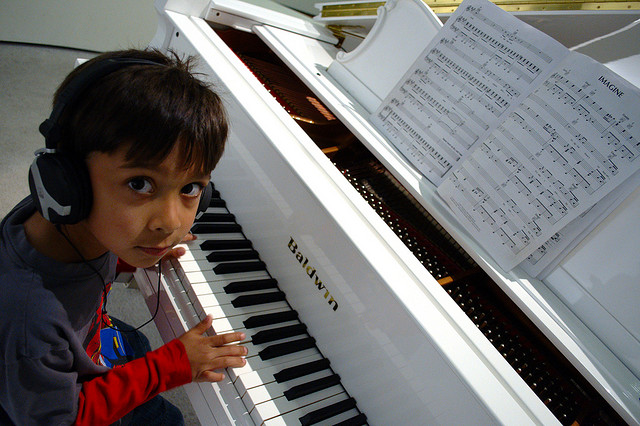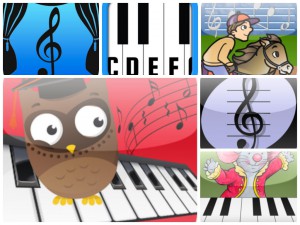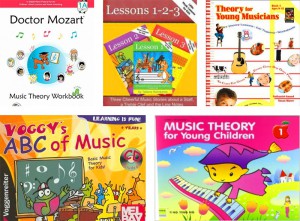Teaching your child to read music might seem like a daunting undertaking to some parents, especially those who aren’t able to read music themselves. Luckily there are some fantastic resources (including books, apps, websites, and free online games) that you can use with your child that will teach them basic music theory and how to read notes in a fun, child-friendly way.

Some people compare learning to read music with learning a foreign language; to be successful, you need commitment, repetition, and lots of practice. Putting a bit of hard work into teaching kids music theory is well worth it because the benefits are endless. Some of the reported benefits include improving the brain’s executive function, attention, memory, and focus. It also helps develop children’s verbal intelligence, reading skills, and much more.
Learn to Read Music Websites and Online Games
There are lots of great websites with games, worksheets, lessons, tips, and activities that can help parents begin to teach their kids about music theory. Here are a few fun sites to have a look at:
- Music Learning Community is a website that has hundreds of learning games of varying levels, all carefully planned to gain mastery of the elements of music theory, ear training, and rhythmic skills. You can get a free 3-week trial or just try some of the games for free.
- Fun and Learn Music is a great website that provides teachers and parents with the materials they need to help their little ones learn basic music theory.
- Music Teachers out of the U.K have a good list of fun online music games for kids.
- The Mighty Maestro has kids’ music theory online lessons. This site has some free activities as well as a paid option.
- Happy Note is another website with lots of games to help kids learn music notes and symbols in a fun way.
- Data Dragon has a good overview of what to learn. Probably best for an older child.
Apps

- Music Theory Helper has all the major music theory topics from reading notes and rhythm to basic harmony. The app includes several interactive controls that make learning to read and play music fun and easy.
- Jellybean Tunes– Play, learn, and compose with a fun, creative, and colorful introduction to music. By interacting directly with notes on the musical staff,
- Music for Little Mozarts was developed for the preschool age group (ages 4-6). It features games that help kids learn about the piano.
- Notes! – Learn To Read Music is a basic flashcard app that helps beginners learn the letter names for notes on the bass and treble clef (“F” on bass through to “G” on treble).
- Flashnote Derby is a fun app for kids to learn and practice identifying music notes by name. The game is a horse race where the user identifies different notes in order to urge their horse and jockey on towards the finish line. Answering quickly and correctly will cause their horse to gain ground, while incorrect answers will cause it to fall behind. At the end of each race, students can review the notes they missed and see the correct answers.
- Treble Cat was designed by professional musicians and educators to help kids and adults learn how to quickly identify notes in the treble clef. This will help improve sight-reading skills.
Music Theory Books for Kids
A great way to teach kids how to read music is by finding the right method book. There are a number of series available for younger kids, mostly geared towards music teachers, but the material is fairly simple, so parents shouldn’t have too much trouble with the lessons. Some theory books specifically mention that they are okay for parents teaching kids at home (Doctor Mozart and Little Music Lessons for Kids: Lessons 1-2-3). Here are a few books to have a look at:

Doctor Mozart Music Theory Workbook teaches music theory in-depth in a fun way using a hands-on approach that involves writing notes, clefs, and musical symbols by hand. This is one of the books that mention on its website that it is good for homeschooling because everything is explained clearly and in detail so it is easy for children and parents to understand.
Music Theory for Young Children by Ying Ying Ng is a series of theory workbooks for young children that incorporate clear symbols and instructions, creative illustrations, intense color, and fun learning techniques, including the use of stickers in exercises. In the first book some of the topics include: the musical alphabet (7 letter names), treble clef, time names and time values, line notes and space notes, treble clef notes (middle C to treble G), bass clef notes (middle C to bass G).
Theory for Young Musicians, Bk 1 (Book & CD) is another popular music theory series for children. Books 1 and 2 contain theory lessons, ear training lessons, and worksheets. This series is designed for students from ages 8 to 12 in their first year of lessons, but can be used at home by parents. This method includes theory lessons, ear training (with CDs for books 1 and 2) and worksheets.
Voggy’s ABC of Music Basic Music Theory for Kids has Voggy explaining the basics of music in a child-friendly manner. This method uses well-known children’s songs to help kids review and practice music theory. It also introduces the most popular musical instruments with pictures as well as sound.
Theory Made Easy for Kids, Level 1 by Alfred Publishing is a theory series that is designed for children ages 4-7. It has colorful illustrations and fun musical sticker sheets in each book.
Little Music Lessons for Kids: Lessons 1-2-3 by Tatiana Bandurina. You can teach your child music theory with help of the series “Little Music Lessons for Kids,” even if you are a total newbie. This series has stories with bright pictures and a cute musical puppy tell your little one about what the music staff is about.
Free Online Videos
A few people (music teachers mostly) have put together a mix of some of the best YouTube videos that can help kids learn how to read music. Anne Crosby Gaudet put together a great selection of free videos that are helpful for learning music theory. Also, this selection from MusicK8 is a pretty good roundup of videos covering a lot of beginning concepts and ideas.
Good luck with teaching your children to read music, remember that it won’t come quickly, but with lots of patience and perseverance they will learn a great skill that will give them a wonderful sense of accomplishment.
If you have any great resources to help kids learn notes and music theory, please let us know in the comments below.
photo credit: Ian Muttoo via photopin cc
